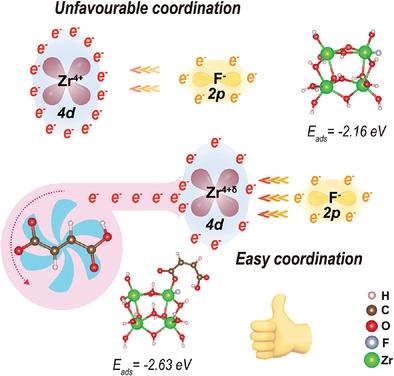当前位置:
X-MOL 学术
›
Adv. Funct. Mater.
›
论文详情
Our official English website, www.x-mol.net, welcomes your
feedback! (Note: you will need to create a separate account there.)
Steering Electron Density of Zr Sites Using Ligand Effect in Bio-Beads for Efficient Defluoridation
Advanced Functional Materials ( IF 18.5 ) Pub Date : 2023-02-21 , DOI: 10.1002/adfm.202213999 Yizhong Zhang 1 , Liuchang Wang 2 , Ruichi Zhang 3 , Chao He 3 , Lixia Jia 4 , Xunliang Wang 1 , Xuemin Feng 1 , Tianxiang Jiang 1 , Baolong Xie 1 , Xiaolei Ma 1 , Junrui Cao 1 , Yuhui Ma 1 , Xin Tan 5 , Tao Yu 6
Advanced Functional Materials ( IF 18.5 ) Pub Date : 2023-02-21 , DOI: 10.1002/adfm.202213999 Yizhong Zhang 1 , Liuchang Wang 2 , Ruichi Zhang 3 , Chao He 3 , Lixia Jia 4 , Xunliang Wang 1 , Xuemin Feng 1 , Tianxiang Jiang 1 , Baolong Xie 1 , Xiaolei Ma 1 , Junrui Cao 1 , Yuhui Ma 1 , Xin Tan 5 , Tao Yu 6
Affiliation

|
Because of spontaneous agglomeration effect and undesirable electronic state of Zr sites on the surface, zirconium (hydro)oxides generally exhibit suboptimal defluoridation capacity. Herein, a template confinement-ligand anchoring strategy is developed by utilizing confined growth of zirconium hydroxide (ZH) inside chitosan hydrogel beads (CHB) and subsequent anchoring of fumaric acid (fm) on its surface Zr sites in a monodentate mononuclear coordination mode. This technique leads to uniform dispersion of ultrafine fmZH (≈3.4 nm) and tunable electron density at the Zr sites. Due to the electron-withdrawing ability of fm, electron-delocalized Zr sites increase the orbital energy level matching and vacate Zr 4d orbitals to promote hybridization with the F 2p orbitals. Ultimately, robust ZrF bond can be formed as a result of reduced the adsorption energy toward fluoride ions. The defluoridation capacity shows positive linear relationship with the electron extraction ability of ligands. The saturation adsorption capacity and dynamic treatment capacity of CHB@fmZH are 10.8 and 45.9 times higher than that of CHB@ZH, respectively, owing to high electron extraction (0.098 e−) of fm. This study offers a novel insight into the design and synthesis of high-efficiency metal oxide adsorbents by steering its surface metal sites’ electronic state through ligand effect.
中文翻译:

利用生物珠中的配体效应控制 Zr 位点的电子密度以实现高效除氟
由于表面上 Zr 位点的自发团聚效应和不良电子态,(氢)氧化物通常表现出次优的除氟能力。在此,通过利用氢氧化锆 (ZH) 在壳聚糖水凝胶珠 (CHB) 内的受限生长以及随后以单齿单核配位模式将富马酸 (fm) 锚定在其表面 Zr 位点上,开发了一种模板限制-配体锚定策略。该技术导致超细 fmZH (≈3.4 nm) 的均匀分散和 Zr 位置的可调电子密度。由于 fm 的吸电子能力,电子离域 Zr 位置增加了轨道能级匹配并腾出 Zr 4d 轨道以促进与 F 2p 轨道的杂化。最终,强大的 Zr 由于对氟离子的吸附能降低,可以形成 F 键。除氟能力与配体的电子提取能力呈正线性关系。由于 fm 的高电子提取 (0.098 e - ),CHB@fmZH 的饱和吸附容量和动态处理容量分别是 CHB@ZH 的 10.8 倍和 45.9倍。本研究通过配体效应控制其表面金属位点的电子态,为高效金属氧化物吸附剂的设计和合成提供了新的见解。
更新日期:2023-02-21
中文翻译:

利用生物珠中的配体效应控制 Zr 位点的电子密度以实现高效除氟
由于表面上 Zr 位点的自发团聚效应和不良电子态,(氢)氧化物通常表现出次优的除氟能力。在此,通过利用氢氧化锆 (ZH) 在壳聚糖水凝胶珠 (CHB) 内的受限生长以及随后以单齿单核配位模式将富马酸 (fm) 锚定在其表面 Zr 位点上,开发了一种模板限制-配体锚定策略。该技术导致超细 fmZH (≈3.4 nm) 的均匀分散和 Zr 位置的可调电子密度。由于 fm 的吸电子能力,电子离域 Zr 位置增加了轨道能级匹配并腾出 Zr 4d 轨道以促进与 F 2p 轨道的杂化。最终,强大的 Zr 由于对氟离子的吸附能降低,可以形成 F 键。除氟能力与配体的电子提取能力呈正线性关系。由于 fm 的高电子提取 (0.098 e - ),CHB@fmZH 的饱和吸附容量和动态处理容量分别是 CHB@ZH 的 10.8 倍和 45.9倍。本研究通过配体效应控制其表面金属位点的电子态,为高效金属氧化物吸附剂的设计和合成提供了新的见解。

































 京公网安备 11010802027423号
京公网安备 11010802027423号